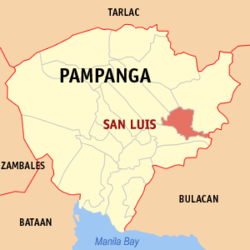San Luis | |
|---|---|
| Municipality of San Luis | |
Luis Taruc Monument Saint Aloysius Gonzaga Parish Church Old San Luis Municipal Hall | |
 Map of Pampanga with San Luis highlighted | |
 Interactive map of San Luis | |
Location within the Philippines | |
| Coordinates: 15°02′24″N120°47′31″E / 15.04°N 120.7919°E | |
| Country | Philippines |
| Region | Central Luzon |
| Province | Pampanga |
| District | 4th district |
| Founded | 1761 |
| Barangays | 17 (see Barangays) |
| Government | |
| • Type | Sangguniang Bayan |
| • Mayor | Jayson S. Sagum |
| • Vice Mayor | Roman A. Sagum |
| • Representative | Anna York P. Bondoc |
| • Municipal Council | Members |
| • Electorate | 38,585 voters (2025) |
| Area | |
• Total | 56.83 km2 (21.94 sq mi) |
| Elevation | 8.0 m (26.2 ft) |
| Highest elevation | 25 m (82 ft) |
| Lowest elevation | 2 m (6.6 ft) |
| Population (2024 census) [3] | |
• Total | 64,674 |
| • Density | 1,138/km2 (2,947/sq mi) |
| • Households | 12,836 |
| Economy | |
| • Income class | 3rd municipal income class |
| • Poverty incidence | 11.86 |
| • Revenue | ₱ 229.5 million (2022) |
| • Assets | ₱ 632.2 million (2022) |
| • Expenditure | ₱ 141.9 million (2022) |
| • Liabilities | ₱ 159.7 million (2022) |
| Service provider | |
| • Electricity | Pampanga 1 Electric Cooperative (PELCO 1) |
| Time zone | UTC+8 (PST) |
| ZIP code | 2014 |
| PSGC | |
| IDD : area code | +63 (0)45 |
| Native languages | Kapampangan Tagalog |
San Luis, officially the Municipality of San Luis (Kapampangan : Balen ning San Luis; Tagalog : Bayan ng San Luis), is a municipality in the province of Pampanga, Philippines. According to the 2024 census, it has a population of 64,674 people. [5]











